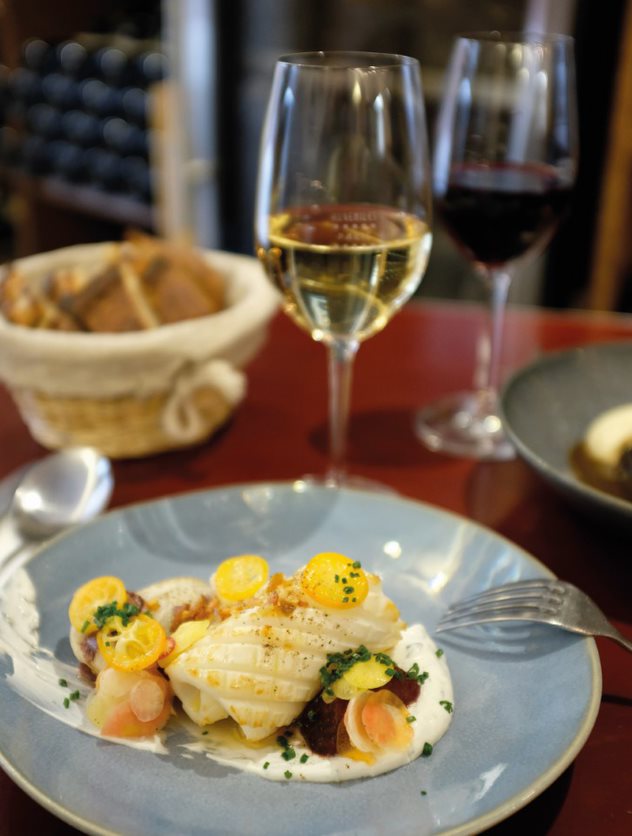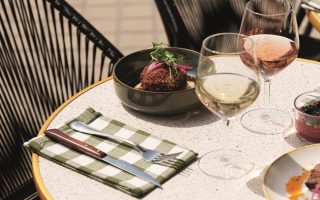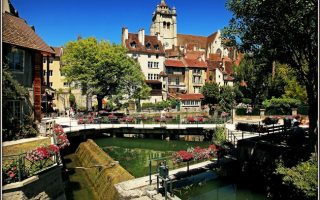Parisian Walkways: Rue de Richelieu

It all began with Cardinal Richelieu, was hijacked by Molière and is now part of Little Tokyo. Jeffrey T Iverson finds out why Rue de Richelieu is beloved by people the world over…
In 2002, sommelier Enrico Bernardo started preparing for the greatest challenge of his career – the Best Sommelier in the World competition. For two years, his daily training programme would include tasting and memorising the aromas of 30 wines – that’s 10,000 wines in one year. Luckily, Bernardo was head sommelier at the Hotel George V, whose cellar boasted 60,000 wines. Still, he had a problem: the competition would include wines from across the world, yet in Paris in 2002, even the city’s most iconic restaurants scarcely had a wine made outside Europe. Thankfully, there was one place in Paris he could find help: a wine bar called Juveniles, at 47 rue de Richelieu.

Grilled squid at Les Juveniles Photo: Jeffrey T Iverson
Juveniles was founded in 1987 by the Scot Tim Johnston and Englishman Mark Williamson of Willi’s Wine Bar (located nearby on Rue des Petits-Champs). Drawn together by a common appreciation of wines from then-unfashionable regions like the Rhône and Languedoc, in 1984, Johnston and Williamson created a wine dealership called Great Grape Traders. After Mark left the business in 1998, Tim carried on running Juveniles and importing – from increasingly distant places. Soon, Juveniles and Willi’s were the only places in Paris serving Australian wines. So when a young Italian sommelier showed up in 2002 hoping to broaden his palate, Johnston was happy to help. “Tim would wait for me after his wine bar closed with a number of new bottles for me to blind taste,” Bernardo recalls in his 2021 memoir, La sagesse du vin. “At Les Juveniles I discovered the wines of the New World… It became a veritable gym for me where I’d go to train and where I made lifelong friendships with Tim and his family.”
AT HOME AND ABROAD
In 2004, Bernardo was crowned Best Sommelier in the World, but years later, he still returns to Rue de Richelieu. “It’s kind of his home now, whenever he’s in Paris he comes here,” says Tim’s daughter Margaux, who now runs Juveniles with her chef husband, Romain.
Over the years, Rue de Richelieu, this ancient street that begins a stone’s throw from the Louvre, has become a home to many foreigners – and lovers of foreign lands. And today, Paris is full of them. “There’s an old idea that Parisians are haughty and close-minded,” says Margaux. “But I think Paris is actually very open to the world, because people today have learned how enriching it is to live that way.” And few streets in the capital embody this openness like Rue de Richelieu, a place rich with culture and history, where every step brings a new call to voyage, a new invitation to discover the myriad colours and flavours of the world.
In 1633, Cardinal Richelieu, Louis XIII’s chief minister, built a palace just north of the Louvre which would become known as the Palais-Royal. On the eastern side of the palace and its gardens, running around 900 metres up to a gate into the capital (today Boulevard des Italiens), a street was built in his name – Rue de Richelieu. Besides being a clergyman and statesman, the Cardinal founded the Académie Française (the institution created to defend the French language), and was a great theatre lover. In an era when the Church scorned acting as unrespectable, Richelieu had a private theatre built in his palace.
After Richelieu died in 1642, his theatre, situated at the beginning of Rue de Richelieu in the 1st arrondissement, remained empty. But in 1660, the King’s brother invited the troupe of Molière, recently returned to Paris, to take up residence here. Today known as Salle Richelieu, the theatre is home to La Comédie Française. Ironically, Molière did little to burnish the legacy of the man whose theatre saved his career. His comedy Les Précieuses ridicules mocked Richelieu’s Académie Française for trying to establish rules of style and manners for French theatre. In the end, the French language that Richelieu had tried to codify became known as “the language of Molière”. The theatre that carries Richelieu’s name is famously called “The House of Molière”. And today, instead of a statue of the Cardinal overlooking his street, it’s one of Molière, located just down the street from the address (nº40) where the playwright died in 1673 after a performance of Le Malade imaginaire.

Passage des Princes Photo: Jeffrey T Iverson
NATIONAL LIBRARY
Another momentous arrival for the street came in 1868 when the Bibliothèque Nationale de France was transferred into newly constructed buildings on Rue de Richelieu. France’s national library had been growing for centuries, and by the late 1800s was the largest repository of books on the planet. In the periodicals department, you could read most of the newspapers published in the world. Archaeologists, historians and collectors came to study its collections of manuscripts, maps and antiquities. In fact, its Cabinet des Médailles, today known as the department of coins, medals and antiques, became the hub for a new trade in the neighbourhood – numismatics.
THE CURRENCY OF HISTORY
An exemplar of that tradition is Maison Platt at 49 rue de Richelieu. Founded in 1880 under the name of Maison Serrure, it’s the oldest numismatic business in France, offering medals, paper currency and coins from the world over. “For me, numismatics has always been about voyages, both in space and time,” says the owner, Daniel Renaud. “As a boy, my father worked in a little bank in the port town of La Rochelle, and he’d bring me coins that the sailors brought back from all the countries in the world, and they fascinated me.” Browsing through Renaud’s collections is like a tour of western civilisation, as one discovers 2,000-year old coins from Ancient Rome and the Byzantine Empire. “Numismatics is a wonderful way to learn the history of the world,” says Renaud. “A simple Roman coin in silver or copper from the 3rd century is a piece of history in your hand. You can see the emperor’s profile, you can read the name in Latin of where it was minted…”
The national library’s arrival in the 19th century was a boon for business. The last Parisian covered arcade of the 19th century, Passage des Princes, opened at 97 rue de Richelieu in 1860. There, between 1879 and 1883, legendary gallery La Vie Moderne exhibited such Impressionists as Renoir and Monet for the first time. In an era when the vogue was for exoticism and Orientalism, Rue de Richelieu became one of the most fashionable streets in Paris, with numerous luxury clothing shops and exotic fabric importers like Au Persan at nº 78 and Compagnie des Indes at nº 80.
Earlier, in 1839, the Austrian entrepreneur August Zang founded the Viennese bakery Boulangerie Viennoise at nº 92. His Viennese specialities became fantastically popular, launching the French mode for viennoiseries or ‘Vienna-style’ pastries. In fact, it was here that the Viennese kipferl, a crescent-shaped pastry, was transformed into France’s beloved croissant.
In the 20th century, Rue de Richelieu and its surrounding streets would continue to draw foreigners with delicious ideas. As Japanese tourism blossomed in France in the 1980s, Japanese businesses began to open up here and on Rue Sainte-Anne, the street to the east of Richelieu, for their proximity to the travel agencies and duty-free shopping of the Quartier Opéra. The area became known as Little Tokyo, and today boasts numerous phenomenal addresses, from Takara, the oldest Japanese restaurant in Paris (opened in 1963) at 14 rue Molière, to Issé, the city’s first izakaya, a Japanese bistro specialising in sake, at 45 rue de Richelieu.
For a generation of French people raised on manga and Japanese animé, Little Tokyo has consolidated France’s love affair with Japan. “I’m not sure I would have gone as deep into my passion for Japanese cuisine if this neighbourhood hadn’t existed,” says entrepreneur Jean-Baptiste Meusnier. “These restaurants showed me there was more than just sushi in Japan.” The dish that most captured his imagination was ramen, the country’s staple noodle soup. Becoming an airline pilot in 2008, Meusnier began visiting Japan frequently, and discovered that every region and city had its own ramen which highlighted local tastes and terroir. Soon he was studying ramen in Japanese cooking schools and dreaming of quitting his job to open his own restaurant.
And in 2016, on Rue Mazarine in Paris, Meusnier opened Kodawari Ramen, offering deliciously authentic ramen with a superb décor evoking a Tokyo back alley. Then in 2019, at 12 rue de Richelieu, he opened Kodawari Ramen Tsukiji, whose ultra-realistic décor plunges the visitor into a Tokyo fish market. “By recreating the ambiances of real, modern-day Japan in my restaurants,” he says, ”I want people to experience this voyage of discovery that I had in Japan.”

Japanese cuisine at Kodawari Ramen. Photo: Jeffrey T Iverson
GLOBAL CUISINE
Another Frenchman helping his compatriots discover tastes from around the world is Olivier Derenne. After years working as an exporter of fine French foods to Japan, in 2008 he decided to start bringing Japanese flavours home to France. In 2017, on Rue Villédo, between Rue de Richelieu and Rue Sainte-Anne, he opened Nishikidori – Le Comptoir des Poivres, a boutique offering some of the most aromatic peppers and spices in the world, and a range of nearly 1,700 products curated from Japan’s 47 provinces. Derenne’s client list includes Japanese restaurants such as Kodawari Ramen and hundreds of French restaurants such as Lucas Carton and Hélène Darroze, as well as pastry chefs like Philippe Conticini and Pierre Hermé.
“French cuisine has changed,” says Derenne. “French cooks have always been very creative, but the new generation is even more open-minded than before. Cuisine is a reflection of our times, of globalisation – it’s a cuisine that incorporates the flavours of the world.”
And on Rue de Richelieu, even the quintessentially French addresses reflect these globalised times. Take Marquise de Laborde at nº29. This elegant boutique celebrates the trousseau de mariage of household linens that all good bourgeois couples would traditionally receive on their wedding, including hand-embroidered bed sheets, tablecloths and bath towels. Yet the boutique’s founder isn’t a marquise, but an enterprising Canadian named Mandy Kerlann who was born in India and married a Burgundy winemaker. “As a foreigner, I feel so welcome here,” she says.
It’s certainly easy to understand why people come to Rue de Richelieu. Here one can taste French cheeses aged with saké or cherry blossoms at the Franco-Japanese cheese shop Fromagerie Hisada (nº47), discover why the French love couscous at Le Comptoir de Tunisie (nº30), stop over for sachertorte at German café Le Stube (nº31), or discover what France Today’s Alexander Lobrano called “the first real modern American restaurant in Paris” – Verjus (nº52), founded by Seattle natives Laura Adrian and chef Braden Perkins. Margaux Johnston of Juveniles is a fan. “It’s true that foreigners have brought a lot to French cuisine in Paris,” she says. We heartily agree.
BOUTIQUES AND RESTAURANTS
KODAWARI RAMEN – TSUKIJI
12 rue de Richelieu, Tel. +33 1 42 61 34 60
Perhaps the most transporting Japanese restaurant in Paris… like the first Kodawari, whose décor plunges the visitor into a Tokyo back alley, this restaurant meticulously recreates the ambiance of the old Tsukiji fish market. The ramen are equally authentic, served with delectable noodles, a fish-based broth and grilled gilt-head bream, sardines and pata negra ham. Come early or expect a queue!
MARQUISE DE LABORDE
29 rue de Richelieu, Tel. +33 1 72 38 26 68
Marquise de Laborde, run by Mandy Kerlann, a Canadian expat, celebrates France’s tradition of luxury linen production, made at her workshop in Beaune. Once devoted solely to private clients, you’d only see her bespoke Egyptian cotton sheets in a copy of Architectural Digest or Elle Décor. Today in her cosy boutique, everyone can discover her handmade linens, napkins and towels and her precious children’s line.
NISHIKIDŌRI – LE COMPTOIR DES POIVRES
6 rue Villédo, Tel. +33 1 42 86 19 59
This delicious shop brings together the two passions of spice hunter Olivier Derenne: the world’s most aromatically moving peppers and spices, and the refined, diverse gastronomy of Japan. Once you taste the potent peppers, aged sakes or exquisite soy sauces, you’ll know why hundreds of French chefs, from Hélène Darroze to Pierre Hermé, are clients here too.
JUVENILES
47 rue de Richelieu, Tel. +33 1 42 97 46 49
This legendary wine bar was founded in 1987 by Brits Tim Johnston and Mark Williamson, two expat wine dealers whose preference for Rhône over Bordeaux and openness to New World cuvées shook up the French wine world. Today Tim’s daughter Margaux and her chef husband Romain have turned Juveniles into a true restaurant with fresh, flavourful, creative cuisine to match their marvellous wine list.
LE STUBE
31 rue de Richelieu, Tel. +33 1 42 60 09 85
Lovers of sauerkraut, currywurst and schnitzel who don’t have time to hop over to Berlin must visit this modern, elegant café founded by German-born chef Gerhard Weber. Come for lunch, stay for kaffee und kuchen, whether it’s a genuine apple streusel, a slice of decadent Schwarzwälderkirschtorte (Black Forest gateau), or Vienna’s legendary chocolate sachertorte, favourite of the Imperial court.
MAISON PLATT
49 rue de Richelieu, Tel. +33 1 42 96 50 48
Maison Platt is the oldest numismatic shop in France, a mecca for collectors of rare coins, paper currency and medals from across the Western World. In a neighbourhood with numerous coin dealers, none offer an ambiance so warm and charming. Owner Daniel Renaud regales visitors with the history of the world’s currencies, then sells them lovely 2, 000-year-old Roman coins for surprisingly modest sums.
From France Today magazine

Roman coins at Maison Platt. Photo: Jeffrey T Iverson
Lead photo credit : The Comedie Francaise on Rue de Richelieu. Photo: Jeffrey T Iverson
Share to: Facebook Twitter LinkedIn Email
Leave a reply
Your email address will not be published. Required fields are marked *



